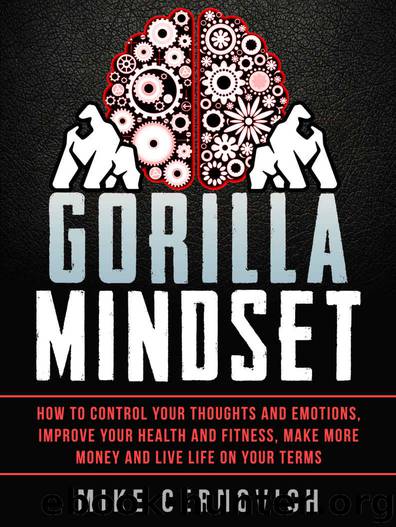Gorilla Mindset: How to Control Your Thoughts and Emotions and Live Life on Your Terms by Mike Cernovich

Author:Mike Cernovich [Cernovich, Mike]
Language: eng
Format: azw3
Tags: health, fitness, money, well-being, emotions, thoughts, nutrition, mindset, focus, finance
Publisher: Gorilla Mindset, LLC
Published: 2015-06-26T16:00:00+00:00
Next, it is important to motivate the behaviors required to reach the goal. We “perform” in the moment by being propelled by two general types of motivation (Ryan & Deci, 2000). We may perform because of personal desires, needs, or values internal to ourselves (Intrinsic Motivation). We may also take action to obtain some sort of external reward, favor, or relationship (Extrinsic Motivation).
Although both types of motivation serve the same function, when possible, it is often better to set goals and perform behaviors that are at least congruent with intrinsic motivations and personal needs. That is why people who work “doing what they love” are often more satisfied and productive than those who work “for a paycheck”. It is also why Mike says that he doesn’t fight himself, and is true to who he is and what he wants. He is being congruent with his intrinsic motivations and using them to drive his behavior.
To stay on track, self-control is important. Staying in the moment, keeping focused, and persisting is not always easy. That is where discipline and self-control come into play. However, self-control tends to operate like a muscle, getting fatigued with repeated use (Muraven & Baumeister, 2000). Therefore, try to juggle too many tasks in a day and you’re bound to let one slip. Fortunately, also like a muscle, self-control gets stronger after repeated exertion and rest.
Thus, to perform in the moment and reach goals, self-control needs to be used judiciously. Ideally, goals and behaviors should be staggered, to give time for rest and recovery. New endeavors should be added one at a time. If that is not possible, then sometimes certain taxing behaviors or routines could be made more automatic and effortless with practice (Bargh & Chartrand, 1999). At other times, perhaps a change in general mood or reframing the task might make it less taxing — called Emotion-Focused Coping (Lazarus & Folkman, 1984).
This is the area where Mike really shines. He streamlines many of his tasks to make them automatic. He keeps a positive focus, reducing stress and making things feel less like “work.” In short, he makes careful use of his limited self-control to maximize success.
Finally, it is important to “test” again and adjust behaviors as necessary to reach goals. That is where the idea of Implementation Intentions comes into play (Gollwitzer, 1999). In short, Implementation Intentions are quick “If X, then Y” statements, that lead to behavior prompts much like conditioned reflexes, or NLP anchors.
For example, if Mike sets certain times to fast, looking at the clock will automatically remind him about his diet (and not to eat yet). Similarly, if he associates certain dominant behaviors with the gym environment, those stimuli will prompt him to “hit it hard” when he walks in. Like Mike, by setting and conditioning these prompts, we can create little behavioral reminders that either keep us on track or help us change focus.
Overall then, looking into the future to plan and acting in the moment are two sides to the same coin of self-development.
Download
This site does not store any files on its server. We only index and link to content provided by other sites. Please contact the content providers to delete copyright contents if any and email us, we'll remove relevant links or contents immediately.
The Compound Effect by Darren Hardy(8724)
Wonder by R.J. Palacio(8379)
Atomic Habits: Tiny Changes, Remarkable Results by James Clear(8118)
Becoming Supernatural by Dr. Joe Dispenza(8032)
Wonder by R. J. Palacio(7865)
Change Your Questions, Change Your Life by Marilee Adams(7554)
The Road Less Traveled by M. Scott Peck(7468)
Born to Run: by Christopher McDougall(7022)
Daring Greatly by Brene Brown(6363)
Big Magic: Creative Living Beyond Fear by Elizabeth Gilbert(5549)
Grit by Angela Duckworth(5444)
The Slight Edge by Jeff Olson(5314)
Men In Love by Nancy Friday(5107)
The Wisdom of Sundays by Oprah Winfrey(5046)
You Are a Badass at Making Money by Jen Sincero(4726)
Fear by Osho(4615)
The Four Tendencies by Gretchen Rubin(4509)
The Miracle Morning by Hal Elrod(4492)
Rising Strong by Brene Brown(4337)
